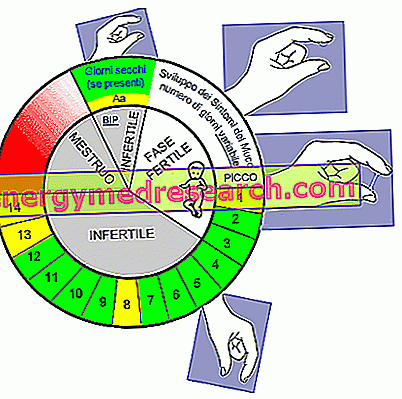Generality
Menstruation in advance is a condition characterized by the shortening of the intermenstrual period.

The time interval between one flow and another is considered to be physiological when it occurs regularly every 28 days, although a frequency of 25 to 36 days can be considered normal and a certain individual variability can not be excluded (the duration of the cycle can change, in fact, from month to month). If menstruation is early, this periodicity is lower, generally due to the shortening of the ovulatory phase.
For women, menstruation that occurs at least 3 days in advance is relatively common : in some cases, the episode is completely casual and has no clinical significance; at other times, the shortening of inter- menstrual periods may indicate the presence of a disorder of the menstrual cycle .
If recurrent or associated with other symptoms, menstruation in advance deserves further investigation from the medical point. To ascertain the reasons for this phenomenon, measurement of hormonal levels in the blood and pelvic ultrasound are usually provided.
Among the possible causes of menstruation in advance are some endocrine dysfunctions, pathologies of the uterus and ovaries, massive intake of drugs and systemic diseases that can weaken the body and cause an imbalance. If necessary, the treatment of menstruation in advance is aimed at triggering factors.
What are
Menstruation in advance is an alteration of the normal duration of the menstrual cycle, which occurs more frequently .
In practice, a shortening of the intermenstrual period occurs, with close flows and a rhythm higher than the regular cycles. If we consider that menstruation lasts from 3 to 7 days, this means that the flow reappears before exceeding 23-25 days after the end of the previous bleeding.
When the phenomenon of menstruation in advance continues for several successive cycles, so it does not represent a transient and occasional problem, the framework of the polymenorrhea is defined.
polymenorrhea
From the clinical point of view, polymenorrhea is defined when menstruation in advance occurs for several months at a rate less than 24 days (in particular, from 15 to 23 days ). The lower periodicity usually indicates a shortening of the ovulation phases.
We speak, on the other hand, of poly-hypermenorrhea when menstruation occurs not only at too short a distance of time, but also with a more abundant and long-lasting flow.
Frequency and duration of menstruation
- Menstruation consists of the exfoliation of the mucosa covering the inner wall of the uterus ( endometrium ), accompanied by a variable blood loss through the vagina . This phenomenon is renewed cyclically every month and lasts, on average, from 3 to 7 days. Menstruation therefore occurs with a regular frequency and with fairly constant duration and quantity characteristics .
- Any changes in the length of the menstrual cycle are more likely to be determined by the length of the period preceding ovulation ( follicular phase ). This first phase of the cycle, despite having an average duration of about 14 days, may undergo fluctuations, which vary from 1 to 3 weeks. For most women, the luteal phase (from ovulation to the beginning of menstruation) is more constant and takes 12 to 16 days (average duration: 14 days). In any case, to be considered regular, between one menstruation and the other there must not be a "waste" exceeding 4 days (more or less).
Menstrual cycle: short note
In common parlance, the term " menstrual cycle " is often used to indicate menstruation, that is, the blood loss that occurs every month and lasts on average from 3 to 7 days . In reality, the menstrual cycle coincides with the interval of time that elapses between a menstruation and the next one.
The menstrual cycle occurs at regular intervals, on average every 28 days, that is from the 1st day of a period to the day before the start of the next flow. However, some individual variability should be considered normal.
Causes and Risk Factors
Premise: what does it mean to have your period?
The first day of menstruation marks the beginning of a new menstrual cycle, which in most women lasts between 25 and 36 days . Regardless of the period of time between two flows, menstruation occurs 14 days after ovulation .
Menstruation allows the uterus to eliminate the inner lining built during the previous cycle (if conception has not occurred). By renewing the mucosal layer of the endometrium, the uterus maintains, from a biological point of view, the "soil" that will host the possibly fertilized egg. These changes occur from puberty to menopause and are directly related to fertility. In other words, menstruation indicates the presence of an ovulation cycle, hence the ability to procreate.
What causes Early Menses?
The causes of menstruation in advance are many . It must be emphasized that, in some cases, this manifestation has no clinical significance, while at other times the problem depends on pathological situations.
Menstruation in advance results frequently from a luteal insufficiency, that is an inadequate production of progesterone from the ovary in the second part of the menstrual cycle. Other possible causes may be hyperprolactinaemia, thyroid abnormalities, etc.

Non-pathological causes
When menstruation in advance is a unique event, or at least sporadic, it should not cause concern, since it can happen that the menstrual cycle presents some irregularities. In fact, trivial reasons such as stress, seasonal changes and fatigue can influence the regularity of menstrual flows. In similar circumstances, in addition to menstruation in advance, it is also possible to observe delays with respect to the days when the appearance of the flow and more abundant losses (menorrhagia) is expected. A more frequent rhythm in the appearance of the menstrual cycle can also occur, without any pathological alteration, for constitutional reasons .
Pathological causes
The pathological causes of menstruation in advance include:
- Hypothalamic-pituitary-ovarian axis dysfunctions (eg progestin deficiency, prolactin hyperproduction or pituitary or thyroid endocrine alterations);
- Anovulatory cycles (the corpus luteum is not formed);
- Altered response of the endometrium to a normal hormonal stimulus .
Menstruation in advance may also indicate the presence of diseases of the female reproductive system, including:
- Endometrial lesions;
- Inflammations of the uterus;
- Endometriosis;
- Ovarian cysts or polycystic ovary syndrome;
- adenomyosis;
- Uterine neoplasms (eg fibroids, polyps of the cervix or endometrium);
- Ovarian tumors.
In mature women, early menstruation can be a symptom of the premenopause . Furthermore, it was statistically observed that women with heart disease are more likely to have polymenorrhea.
In other cases, menstruation in advance may be the expression of general debilitating diseases of the organism (eg anemia, infections, neoplastic processes, etc.) or the consequence of high levels of psycho-physical stress (eg miscarriage, excessive physical activity, malnutrition, mourning etc.). It should also be considered that the phases of the menstrual cycle are associated with the periodic and regular secretion of the ovarian, hypothalamic and pituitary hormones, directly related to fertility. Consequently, different structures of the body (central nervous system, hypothalamus, pituitary and ovary) contribute to maintaining the regularity of menstruation, ovulation and other related events.
Symptoms and Complications
Menstruation in advance is manifested by more frequent and frequent menstrual flows.
This condition in itself is not associated with other particular physical ailments. Sometimes, if menstruation in advance appears in the context of pathological changes in the menstrual cycle, it is also possible to observe more abundant delays and losses (menorrhagia).
A possible consequence of the set of such anomalies is the difficulty in conception.
Diagnosis
Episodic Early Menses
Menstruation in advance may occur occasionally and should not alarm; often, at the base of the problem, there can be abrupt changes in weight, climate changes, intake of particular drugs, stress, fatigue, anxiety and considerable concerns.
If occasional or accompanied to normal flows in quantity and duration, menstruation in advance does not have a serious pathological significance, but should not be neglected. In the perimenopausal period, for example, it is always advisable to consult a doctor (although menstruation in advance is a physiological event) and, possibly, a check-up to ascertain that this event does not depend on other conditions.
Recurrent Early Menses
If menstruation in advance recurs unusually several times over several months, it is advisable to contact your GP or reference gynecologist for the appropriate diagnostic tests. In relation to clinical suspicion, the execution of hormonal dosages, pelvic ultrasound and any other tests may be indicated.
Among the various causes that lead to the recurrence of menstruation in advance, there may be alterations of hormonal secretion by the ovary or other endocrine glands, which must be correctly identified and treated. Similarly, it is necessary to promptly identify diseases from the genital tract or tumor growths.
Menstruation in Advance: which exams do you need?
To evaluate the causes responsible for menstruation in advance, it is necessary to record precisely on the menstrual calendar the beginning of each cycle (ie the day on which the flow appears).
To learn more: Menstrual Calendar - What to Pay Attention to »Your doctor may require some blood tests that include measuring the levels of hormones involved in the menstrual cycle.
The execution of an ultrasound and a pelvic exam will check the conditions of the uterus and ovaries, and the possible presence of cysts (polycystic ovary), as well as allowing to measure the thickness of the endometrium or to identify other anomalies of the ovulation. Other tests, such as MRI, are sometimes necessary to identify the physical causes of menstruation in advance.
Treatment and Remedies
The treatment of menstruation in advance must be directed towards the cause that is responsible for it.
If specific pathologies are not found, menstruation in advance may represent a transient condition. In any case, for the therapy or the most suitable indications, it is always recommended to contact a specialized doctor.
Useful tricks
In general, if menstruation in advance is a sporadic or occasional condition, the woman should not worry too much about it.
Sometimes, it is possible to manage the condition simply by adopting an adequate diet, the practice of moderate exercise, stress control and other lifestyle changes .
Polymenorrhea should cause serious concerns, instead, when it appears as a recurrent phenomenon, except, of course, for women who approach menopause.
Drugs and surgery
The regularization of menstruation is possible only if it becomes the effect of the normalization of the functional relationships between the pituitary, the ovary and the uterus.
In the most serious cases, that is when menstruation in advance is a reason for disorders or sterility, the doctor can direct the patient towards a pharmacological treatment aimed at solving the problem. In particular, a hormonal therapy may be prescribed, based on the assumption of a estrogen-progestin contraceptive, to be performed for several menstrual cycles. In cases of luteal insufficiency, the doctor may indicate, instead, the use of progesterone orally or vaginally, at fixed days during the cycle, to compensate for the production defect.
On some occasions, the solution to the disease that causes menstruation in advance is surgery .



